Erotic art in Pompeii and Herculaneum
This article needs additional citations for verification. (April 2008) |

Erotic art in Pompeii and Herculaneum has been both exhibited as art and censored as pornography. The Roman cities of Pompeii and Herculaneum around the bay of Naples were destroyed by the eruption of Mount Vesuvius in 79 AD, thereby preserving their buildings and artefacts until extensive archaeological excavations began in the 18th century. These digs revealed the cities to be rich in erotic artefacts such as statues, frescoes, and household items decorated with sexual themes.
The ubiquity of such imagery and items indicates that the treatment of sexuality in ancient Rome was more relaxed than in current Western culture. The creation of erotic art in ancient Rome is thought to have occurred over seven centuries from the first century BCE to the fifth or sixth century CE.[1]
Much of what might strike modern viewers as erotic imagery, such as oversized phalluses, could arguably be fertility imagery. Depictions of the phallus, for example, could be used in gardens to encourage the production of fertile plants.
This clash of cultures led to many erotic artefacts from Pompeii being locked away from the public for nearly 200 years. In 1819, when King Francis I of Naples visited the Pompeii exhibition at the Naples National Archaeological Museum with his wife and daughter, he was embarrassed by the erotic artwork and ordered it to be locked away in a "secret cabinet", accessible only to "people of mature age and respected morals". Re-opened, closed, re-opened again and then closed again for nearly 100 years, the Secret Museum, Naples was briefly made accessible at the end of the 1960s (the time of the sexual revolution) and was finally re-opened for viewing in 2000. Minors are still only allowed entry to the once-secret cabinet in the presence of a guardian, or with written permission.
Phalluses
[edit]The phallus (the erect penis), whether on Pan, Priapus or a similar deity, or on its own, was a common image. It was not seen as threatening or even necessarily erotic, but as a ward against the evil eye.[2][3] The phallus was sculpted in bronze as tintinnabula (wind chimes). Phallus-animals were common household items.
-
Bronze tintinabulum; phallus in the form of a winged lion, with suspended chimes. 1st Century BCE
-
Relief of a Phallus on a lava paving stone showing directions to a brothel on the Via dell' Abbondanza. Pompeii.
-
Phallus relief from Pompeii, c. 1–50 AD
-
A phallus from a public alleyway in Pompeii that was 2 meteres up the side of a wall. The inscription reads "I shat out this one phallus/prick".[4] Tufa. Painted.
-
A phallus on the side of a building in Pompeii. Terracotta plaques with images of phalluses were set into the walls on streets in Pompeii.[4]
Priapus
[edit]A wall fresco which depicted Priapus, the god of sex and fertility, with his oversized erection, was covered with plaster (and, as Karl Schefold explains, even the older reproduction below was locked away "out of prudishness" and only opened on request) and only rediscovered in 1998 due to rainfall.[5] The Romans believed that he was a talisman protecting the riches of the house.
The second image, from Schefold, Karl: Vergessenes Pompeji: Unveröffentlichte Bilder römischer Wanddekorationen in geschichtlicher Folge. München 1962., with its much more brilliant colors, has been used to retouch the younger, higher resolution image here.
A statuette of Priapus in the House of the Vettii in Pompeii is from a small cubicle leading off from the kitchen. It is thought the statue used to be placed in the garden and was used as a fountain. A hole runs through its phallus allowing it to spurt like a fountain. Also in this room where the statue was located were erotic paintings.
-
A statuette of Priapus in the House of the Vettii. A hole runs through its phallus allowing it to spurt like a fountain.
-
Wall Painting of Priapus, House of the Vettii
-
A fresco of Venus and Priapus. Above them is a landscape. House at I. 62 - 79 CE
-
A second image of the wall painting. House at I. 62 - 79 CE
Brothels
[edit]
It is unclear whether the images on the walls were advertisements for the services offered, or if they were merely intended to heighten the pleasure of the visitors. As previously mentioned, some of the paintings and frescoes became immediately famous because they represented erotic, sometimes explicit, sexual scenes.
One of the most curious buildings recovered was in fact, a Lupanar(brothel), which had many erotic paintings and graffiti inside. The erotic paintings seem to present an idealised vision of sex at odds with the reality of the function of the lupanar. The Lupanare had 10 rooms (cubicula, 5 per floor), a balcony, and a latrina. It was not the only brothel. The town seems to have been oriented to a warm consideration of sensual matters: on a wall of the Basilica (sort of a civil tribunal, thus frequented by many Roman tourists and travelers), a piece of graffiti tells the foreigner: If anyone is looking for some tender love in this town, keep in mind that here all the girls are very friendly (loose translation). Other inscriptions reveal some pricing information for various services: Athenais 2 As, Sabina 2 As (CIL IV, 4150), The house slave Logas, 8 As (CIL IV, 5203) or Maritimus licks your vulva for 4 As. He is ready to serve virgins as well. (CIL IV, 8940). The amounts vary from one to two asses up to several sesterces. In the lower price range, the service was not more expensive than a loaf of bread.
Prostitution was relatively inexpensive for the Roman male, but it is important to note that even a low priced prostitute earned more than three times the wages of an unskilled urban labourer.[citation needed] However, it was unlikely a freed woman would enter the profession in hopes for wealth because most women declined in their economic status and standard of living due to demands on their appearance as well as their health.
Prostitution was overwhelmingly an urban creation. Within the brothel, it is said [clarification needed]prostitutes worked in a small room usually with an entrance marked by a patchwork curtain. Sometimes, the woman's name and price was placed above her door. Sex was generally the cheapest in Pompeii, compared to other parts of the Empire.[citation needed] All services were paid for with cash.
- Wall paintings from the Lupanar
-
Erotic frescos on the walls of the Lupanar brothel
-
Erotic Fresco from the Lupanar brothel. 72 - 79 CE[6]
-
Fresco from the Lupanar brothel, the largest Pompeii brothel. 72 - 79 CE
-
Erotic Fresco from the Lupanar, Pompeii. 72 - 79 CE
-
Erotic Fresco from the Lupanar, Pompeii. 72 - 79 CE
-
Erotic Fresco Lupanar, Pompeii. 72 - 79 CE
Suburban baths
[edit]
The Suburban Baths are located near the Marine Gate in Pompeii.[7][8] In one room, thought to be a dressing room,[9] there are seven wall paintings of sexual scenes and one of a figure with an enlarged scrotum.[8]

These eight paintings are located above paintings of numbered boxes sitting on a shelf.[8][1] These wall paintings were found in 1986[8][1] when the room was first excavated. The paintings are dated to 62 to 79 CE.[8][1] The building that the baths are in is two stories with the baths taking up the ground floor.[8]

The function of the wall paintings is not yet clear: some authors say that they indicate that the services of prostitutes were available on the upper floor of the bathhouse and could be a sort of advertising, while others prefer the hypothesis that their only purpose was to decorate the walls with joyful scenes, as these were in Roman culture.
Another idea is that both the paintings of sexual scenes and the paintings of boxes with numerals on them were related to the use of spintria tokens that gave people access to a locker in the dressing room.[11][10]
Each wall painting of a sexual scene has a painting just below it of a box with a number on it.[8][12] It is thought that there were actual boxes that were placed under these paintings.[9][8] These boxes would have been placed on a wooden shelf.[9][8][12] This wooden shelf would have run along two walls of this dressing room just underneath where the paintings of numbered boxes are.[9][8] There are some holes in the rear and right wall where brackets that held the shelves could have been.[9][8] It is thought that these boxes that were sitting on this wooden shelf under these paintings would have been where people attending the baths would have put their clothes after they had undressed in this room.[8] The only remains of the boxes themselves are metal straps.[12] In the wall paintings of the boxes an "X" shape at the front of the boxes indicates where the straps were.[1] The wall painting also shows the wooden shelf underneath the boxes.[8]
Spintria tokens have a numeral on one side and an image of a sexual scene on the other.[12] It is speculated that the sexual scenes and numerals on the tokens related[11] to the wall paintings of sexual scenes and numerals in the dressing room.[11] When the token was given to a person it then gave them access to a place to put their clothing.[11] Possibly they may have put their clothing inside the box that was sitting on the wooden shelf in the dressing room.[8]
It has been commented that "Graffiti from Pompeii, Herculaneum and 2nd century Ostia Antica, often refer to group sex, although none describe the pose of scene VI [from the suburban baths]."[13][14]
- Wall paintings from the dressing room in the suburban baths
-
Fresco showing a cowgirl position. A ferret is on the knee of one of the figures. Suburban baths, Pompeii. 62 to 79 CE
-
An erotic scene on a bed. Wall painting. Suburban baths, Pompeii. 62 to 79 CE
-
Fellatio. Wall painting. Suburban baths, Pompeii. 62 to 79 CE
-
Fresco depicting cunnilingus. Suburban baths, Pompeii. 62 to 79 CE
-
Lesbian sex scene. The patches of dark green color are remains of the repainting of the wall. Suburban baths, Pompeii. 62 to 79 CE
-
Sex between a female and two males. Wall painting. Suburban baths, Pompeii. 62 to 79 CE
-
Cunnilingus, fellatio and anal sex between two females and two males. Wall painting, Suburban baths. Pompeii. 62 to 79 CE
-
A nude male with an enlarged scrotum holding a scroll. Wall painting. Suburban baths, Pompeii. 62 to 79 CE
Venus
[edit]
Venus was the divine protector of Pompeii, and featured in many frescoes around the city.[15] The goddess of love, sex, and fertility, Venus was closely associated with eroticism and prostitution in ancient Rome.[16] The mural of Venus from Pompeii may have been a Roman copy of the then famous painting by Apelles which Lucian mentioned.[citation needed]
The fresco of Mars and Venus, located in the tablinum of the House of Mars and Venus, is believed to model the proper family roles of husband and wife for those entering the home. Mars and Venus, a popular couple from mythology, were represented in many houses' tablinum for this reason.[17] Venus has appeared in Pompeian artwork at least 197 times,[18] the majority of these depictions located in a home's reception area where a guest would not need an invitation to enter, although she also appears on tavern signs and political banners.[19] Previous scholarship assumed Venus would be more common in cubicula, small inclosed rooms that may function as a bedroom, due to her association with love and sex. Recent studies have shown this is not the case and that Venus is more commonly portrayed in large common rooms.[18] Approximately one third of artwork featuring Venus represents some sort of love scene.[20] There are two Venus types found almost exclusively in Pompeii, Venus Pompeiana ("Venus of Pompeii") and Venus Pescatrice ("Venus the Fisher-woman"). Venus Pompeiana is depicted standing rigidly, usually trapped with a mantle and holding her right arm across her chest.[20] She is most commonly depicted in places that would be seen by many people, possible to demonstrate a house's patron goddess or for protection as this form of Venus has special religious and ritual significance to Pompeii. Venus Pescatrice is typically shown sitting down, holding a fishing rod and is always semi-naked.[18] The depictions of Venus Pescatrice are all similar in structure, suggesting they derive from the same source, though this source has not been found.[18]
-
Mural of Venus
Erotic art outside Pompeii and Herculaneum
[edit]In Ostia Antica in the House of the Painted Vaults there are two wall paintings of sexual scenes in one room.[21] It is speculated that in this room there was once six to eight paintings of sex between two people on beds.[21]
-
West wall painting. Excavation photo. Fresco. House of the Painted Vaults. Ostia Antica. mid-3rd century CE.[1]
-
South wall painting. Excavation photo. Fresco. House of the Painted Vaults. Ostia Antica. mid-3rd century CE.[1]
-
South wall painting. Fresco. House of the Painted Vaults. Ostia Antica. mid-3rd century CE.[1]
-
Above the two figures on a bed is an image inside a wooden shutter or pinax. This image shows a sexual scene between two people. Bronze mirror cover. Found on the Esquiline Hill. Capitoline Museums, Rome.[22] 70 - 90 CE
-
A winged female figure straddling a sleeping male with an erection in a rustic landscape.The winged figure may be a siren while the sleeping figure may be a shepherd. The winged figure also has bird feet. Relief. Marble. Museum of Fine Arts, Boston. 2nd century CE
-
Sex between two females and two males.[1] On the right are two females and the figure furthest to the right has raised their legs around the person next to them.[1] On the left is anal sex between two males.[1]Fragment of a terracotta vessel. Stamped with the name Vitalis. Vorarlberg museum, Austria. 65 - 80 CE
-
Sex between a female and a male. At the right of the image is sex between two males. Arretine Bowl. Terracotta. late 1st century BCE. Museum of Fine Arts, Boston
-
Pottery lamp-filler.[23] A second description is of a "terracotta vase". 120 - 70 BCE
-
Eros and Psyche. 200 - 100 BCE
-
Cupid and Psyche. A Roman copy after a Greek statue. The Greek statue is dated to the 2nd century BCE. Marble. Capitoline Museums, Rome
-
A dancer. Statuette. Bronze. From Civita. National Archaeological Museum, Naples. End of the first century BCE
-
A rhyton in the shape of a phallus. In relief on the outside of the rhyton is sex between a female and a male. Found in the necropolis of Les Corts near the roman city of Empúries. Archaeology Museum of Catalonia, Empúries, Girona. 1st century BCE.
Gallery
[edit]- Mythology
-
A statuette of Aphrodite with eros. Some of the body decoration is gilt. From Pompeii. National Archaeological Museum, Naples.
-
Polyphemus and Galatea kissing. Fresco from a Pompeii sleeping room. Naples National Archaeological Museum. around 50 CE – 79 CE
-
Fresco showing Leda and the swan, from Pompeii, National Archaeological Museum, Naples 50–79 CE
-
Fresco showing Leda and the swan. From Pompeii.
-
Venus and Eros. Wall painting from Pompeii.
- Nymph, Maenad and Satyr
-
Tile mosaic, Nymph and a Satyr, House of the Faun.
-
A Nymph or Maenad sleeping in a landscape with a Satyr approaching. From Pompeii. Around 50–79 CE.
-
Maenad and a Satyr, from Pompeii
-
Nymph and Satyr. Found in a field in Pollena Trocchia. National Archaeological Museum, Naples. 1st century CE
- Erotic scenes
-
Marble bas-relief from Pompeii. National Archaeological Museum, Naples.
-
A sexual scene on a bronze vessel handle. From Pompeii. 1st century CE
-
Erotic scene on the Nile. Roman fresco on summer triclinium of the House of the Ephebus. Pompeii.
-
Wall painting from Pompeii. 40 - 45 BCE
-
Wall painting from Pompeii.
-
Wall painting from Pompeii. Around 50 to 79 CE.
-
Wall painting from Pompeii
-
Sex between a female and a male.The figure on the left is wearing a strophium which is a kind of bra or bikini top.[24] From the House of the Centenary, Pompeii. Around 70CE
-
Wall painting. Pompeii. 1st century CE
-
A second image of the same wall painting. Pompeii. 1st Century CE
-
An erotic wall painting on the west wall of a small room at the side of the kitchen from The House of the Vettii, Pompeii. [25]
-
Erotic wall painting East wall. House of the Vetti, from Pompeii
-
Erotic wall painting. North Wall, House of the Vetti. from Pompeii
-
Erotic wall painting. South wall. Casa del Ristorante. Pompeii
-
Erotic wall painting. West wall. Casa del Ristorante. Pompeii
-
Erotic wall painting. North wall Casa del Ristorante. Pompeii
-
Erotic wall painting. North wall. Casa del Ristorante. Pompeii
-
Erotic wall painting, House of the King of Prussia, Pompeii
-
Erotic wall painting, from Pompeii, National Archaeological Museum, Naples.
-
Sex between a female and a male.The figure on the left has a garland of rose petals around their head. The figure to the right is wearing a strophium which is a kind of bra or bikini top.[24] Pompeii. Around 70CE
-
Erotic wall painting, from Pompeii. National Archaeological Museum, Naples.
-
Erotic wall painting, from Pompeii. National Archaeological Museum, Naples. 62 - 79 CE
-
Erotic wall painting, from Pompeii. National Archaeological Museum, Naples.
-
Sexual scene - House at I. 13, 16 - Pompeii
-
Drawing by César Famin of a Roman fresco from the Osteria della Via di Mercurio in Pompeii.[26] It is thought that the fresco showed the two people above two lines and these two lines were shadows.[26] It is thought that in this drawing the two lines have been drawn as tightropes that the two people are balancing on.[26] The fresco has since been destroyed. This drawing is dated to 1827.[26][27]
See also
[edit]References
[edit]- ^ a b c d e f g h i j k l m John R. Clarke (1998). Looking at Lovemaking Constructions of Sexuality in Roman Art, 100 B.C. – A.D. 250. University of California Press. ISBN 9780520229044.
- ^ Johns, C. "3: The Phallus and the Evil Eye". Sex or Symbol? Erotic Images of Greece and Rome. British Museum.
- ^ Parker, A. (2017). "Protecting the Troops? Phallic Carvings in the north of Roman Britain". In Parker, A. (ed.). Ad Vallum: Papers on the Roman Army and Frontiers in Celebration of Dr Brian Dobson. BAR British Series 631. BAR Publishing. pp. 117–30.
- ^ a b John R. Clarke (2007). Looking at Laughter Humor, Power, and Transgression in Roman Visual Culture, 100 B.C.- A.D. 250. University of California Press. pp. 70–71. ISBN 9780520237339.
- ^ As reported by the Evangelischer Pressedienst press agency in March 1998.
- ^ a b John R. Clarke (April 2001). Looking at Lovemaking Constructions of Sexuality in Roman Art, 100 B.C. – A.D. 250. University of California Press. p. 205. ISBN 9780520229044.
- ^ "Repubblica.it/Galleria di immagini: Le terme del piacere: L'interno delle terme suburbane". repubblica.it.
- ^ a b c d e f g h i j k l m n o p John R. Clarke (2007). Looking at Laughter Humor, Power, and Transgression in Roman Visual Culture, 100 B.C.- A.D. 250. University of California Press. ISBN 9780520237339.
- ^ a b c d e f Luciana Jacobelli (1989). "Le pitture e gli stucchi delle terme suburbane di Pompei" Inhalt 4. Internationales Kolloquium zur Römischen Wandmalerei Köln. Kölner Jahrbuch für Vor- und Frühgeschichte (in German). Vol. 24 (published 1991). pp. 72–74. ISBN 978-3-786-11682-0. Retrieved 16 March 2024.
- ^ a b Duggan, Eddie (October 2017). "Stranger Games: The life and times of the spintriae". Board Game Studies Journal. 11 (1): 101–121. doi:10.1515/bgs-2017-0005. S2CID 67801461.
- ^ a b c d e Fishburn, Geoffrey (11 July 2007). "Is that a Spintria in your Pocket, or Are You Just Pleased to See Me?" (PDF). Regarding the Past. 20th Conference of the History of Economic Thought Society of Australia. Brisbane: University of Queensland Printery. pp. 225–236. ISBN 9781864998979. Archived from the original (PDF) on 17 April 2022.
- ^ a b c d John R Clarke (1998). Looking at Lovemaking Constructions of Sexuality in Roman Art, 100 B.C.-A.D. 250. University of California Press. p. 244. ISBN 9780520229044.
- ^ Scene VI is a scene of sex between a female and two males in the suburban baths
- ^ John R. Clarke (April 2001). Looking at Lovemaking Constructions of Sexuality in Roman Art, 100 B.C. – A.D. 250. University of California Press. p. 234. ISBN 9780520229044.
- ^ The world of Pompeii. John Joseph Dobbins, Pedar William Foss. London: Routledge. 2007. ISBN 978-0-415-17324-7. OCLC 74522705.
{{cite book}}: CS1 maint: others (link) - ^ Lacroix P History Of Prostitution Among All The Peoples Of The World From The Most Remote Antiquity To The Present Day Translated From The Original French By Samuel Putnam Vol 3 1926.
- ^ Spinelli, Ambra (2022-01-19). "Beyond social and functional interpretations of wall paintings: mythological imagery in the tablinum at Pompeii and Herculaneum". Journal of Roman Archaeology. 35: 177–193. doi:10.1017/S1047759421000581. ISSN 1047-7594. S2CID 250284236.
- ^ a b c d Brain, Carla (2019-12-17). "Painting by Numbers: A Quantitative Approach to Roman Art". Theoretical Roman Archaeology Journal. 2 (1): 10. doi:10.16995/traj.376. ISSN 2515-2289. S2CID 209429357.
- ^ Grant, Michael (2005). Cities of Vesuvius : Pompeii and Herculaneum. London: Phoenix Press. ISBN 1-898800-45-6. OCLC 61680895.
- ^ a b Brain, Carla (2017-03-23). "Venus in Pompeian Domestic Space: Decoration and Context". Theoretical Roman Archaeology Journal (2016): 51. doi:10.16995/TRAC2016_51_66. ISSN 2515-2289.
- ^ a b c John R Clarke (1998). Looking at Lovemaking Constructions of Sexuality in Roman Art, 100 B.C.-A.D. 250. University of California Press. pp. 274–275. ISBN 9780520229044.
- ^ Mulas, Antonia (1978). Eros in antiquity. New York: Erotic Art Book Society.
- ^ Johns, Catherine (1982). Sex Or Symbol? Erotic Images of Greece and Rome. British Museum Publications. ISBN 9780714180427.
- ^ a b Michael Grant (1975). "Erotic art in Pompeii" The secret collection of the national museum of Naples". Octopus Books. p. 155. ISBN 0-7064-0460-2.
- ^ Michael Grant (1975). "Erotic art in Pompeii" The secret collection of the national museum of Naples". Octopus Books. p. 52. ISBN 0-7064-0460-2.
- ^ a b c d John R. Clarke (2007). Looking at Laughter Humor, Power, and Transgression in Roman Visual Culture, 100 B.C.- A.D. 250. University of California Press. p. 210. ISBN 9780520237339.
- ^ John R. Clarke (2009). Ars erotica: Sexualität und ihre Bilder im antiken Rom (in German). Darmstadt: Primus. ISBN 978-3896783974.
Bibliography
- Clarke, John (2003). Roman Sex: 100 B.C. to A.D. 250. New York: Harry N. Abrams. ISBN 978-1626548800.
- Grant, Michael; Mulas, Antonia (1997). Eros in Pompeii: The Erotic Art Collection of the Museum of Naples. New York: Stewart, Tabori and Chang. ISBN 978-1556706202.
- McGinn, Thomas A.J. (2004). The Economy of Prostitution in the Roman World. Ann Arbor: The University of Michigan Press. ISBN 978-0472113620.
- Varone, Antonio (2001). Eroticism in Pompeii. Getty Trust Publications. J. Paul Getty Museum. ISBN 978-0892366286.

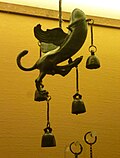


![A phallus from a public alleyway in Pompeii that was 2 meteres up the side of a wall. The inscription reads "I shat out this one phallus/prick".[4] Tufa. Painted.](http://upload.wikimedia.org/wikipedia/commons/thumb/f/fa/Phallus_-_Tufa_-_Pompeii_-_1.jpg/120px-Phallus_-_Tufa_-_Pompeii_-_1.jpg)
![A phallus on the side of a building in Pompeii. Terracotta plaques with images of phalluses were set into the walls on streets in Pompeii.[4]](http://upload.wikimedia.org/wikipedia/commons/thumb/f/fc/Phallus_-_Pompeii_2.png/120px-Phallus_-_Pompeii_2.png)



![Wall painting of Priapus with two phalluses in the Lupanar 72 -79 CE [6]](http://upload.wikimedia.org/wikipedia/commons/thumb/6/6f/In_situ_wall_fresco_with_erotic_scene_in_the_Lupanar_%2C_Pompeii_%2814673356410%29.jpg/171px-In_situ_wall_fresco_with_erotic_scene_in_the_Lupanar_%2C_Pompeii_%2814673356410%29.jpg)

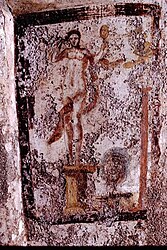
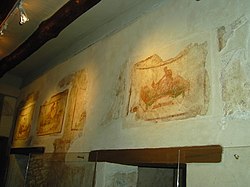
![Erotic Fresco from the Lupanar brothel. 72 - 79 CE[6]](http://upload.wikimedia.org/wikipedia/commons/thumb/a/a6/Unidentified_fresco_painting_in_Pompeii%2C_2016_%281%29.jpg/250px-Unidentified_fresco_painting_in_Pompeii%2C_2016_%281%29.jpg)
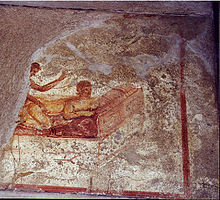



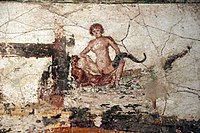








![A wall painting of a sexual scene on the west wall of a room of the House of the Painted Vaults. Ostia Antica. This photo taken in 1938 soon after excavations began.[21] Fresco. mid-3rd century CE.[1]](http://upload.wikimedia.org/wikipedia/commons/thumb/7/7b/Ostia_Antica_-_House_of_the_painted_Vaults_-_room_5_-_west_and_south_wall.jpg/180px-Ostia_Antica_-_House_of_the_painted_Vaults_-_room_5_-_west_and_south_wall.jpg)
![West wall painting. Excavation photo. Fresco. House of the Painted Vaults. Ostia Antica. mid-3rd century CE.[1]](http://upload.wikimedia.org/wikipedia/commons/thumb/5/5f/Ostia_Antica_-_House_of_the_painted_Vaults_-_room_5_-_west_wall.jpg/180px-Ostia_Antica_-_House_of_the_painted_Vaults_-_room_5_-_west_wall.jpg)
![South wall painting. Excavation photo. Fresco. House of the Painted Vaults. Ostia Antica. mid-3rd century CE.[1]](http://upload.wikimedia.org/wikipedia/commons/thumb/e/e1/Ostia_Antica_-_House_of_the_painted_Vaults_-_room_5_-_south_wall_-_wall_painting.jpg/180px-Ostia_Antica_-_House_of_the_painted_Vaults_-_room_5_-_south_wall_-_wall_painting.jpg)
![South wall painting. Fresco. House of the Painted Vaults. Ostia Antica. mid-3rd century CE.[1]](http://upload.wikimedia.org/wikipedia/commons/thumb/9/97/Ostia_Antica_-_House_of_the_Painted_Vaults_-_room_5_-_south_wall_-_wall_painting_-_3.jpg/180px-Ostia_Antica_-_House_of_the_Painted_Vaults_-_room_5_-_south_wall_-_wall_painting_-_3.jpg)
![Above the two figures on a bed is an image inside a wooden shutter or pinax. This image shows a sexual scene between two people. Bronze mirror cover. Found on the Esquiline Hill. Capitoline Museums, Rome.[22] 70 - 90 CE](http://upload.wikimedia.org/wikipedia/commons/thumb/4/4e/Clarke_Ars_Erotica_18.jpg/179px-Clarke_Ars_Erotica_18.jpg)

![Sex between two females and two males.[1] On the right are two females and the figure furthest to the right has raised their legs around the person next to them.[1] On the left is anal sex between two males.[1]Fragment of a terracotta vessel. Stamped with the name Vitalis. Vorarlberg museum, Austria. 65 - 80 CE](http://upload.wikimedia.org/wikipedia/commons/thumb/a/ad/Relief_-_3a.jpg/180px-Relief_-_3a.jpg)

![Pottery lamp-filler.[23] A second description is of a "terracotta vase". 120 - 70 BCE](http://upload.wikimedia.org/wikipedia/commons/thumb/f/f9/Vessel_-_terracotta_statuette_-_1a.jpg/180px-Vessel_-_terracotta_statuette_-_1a.jpg)





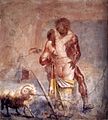







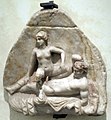






![Sex between a female and a male.The figure on the left is wearing a strophium which is a kind of bra or bikini top.[24] From the House of the Centenary, Pompeii. Around 70CE](http://upload.wikimedia.org/wikipedia/commons/thumb/f/ff/Pompeii_-_Casa_del_Centenario_-_Cubiculum_2.jpg/106px-Pompeii_-_Casa_del_Centenario_-_Cubiculum_2.jpg)


![An erotic wall painting on the west wall of a small room at the side of the kitchen from The House of the Vettii, Pompeii. [25]](http://upload.wikimedia.org/wikipedia/commons/thumb/1/1d/Pompeii_-_House_of_the_Vetti_-_2.jpg/120px-Pompeii_-_House_of_the_Vetti_-_2.jpg)








![Sex between a female and a male.The figure on the left has a garland of rose petals around their head. The figure to the right is wearing a strophium which is a kind of bra or bikini top.[24] Pompeii. Around 70CE](http://upload.wikimedia.org/wikipedia/commons/thumb/e/e5/Fragment_of_wall_painting_with_erotic_scene%2C_from_Pompeii%2C_Naples_National_Archaeological_Museum_%2817297820526%29.jpg/116px-Fragment_of_wall_painting_with_erotic_scene%2C_from_Pompeii%2C_Naples_National_Archaeological_Museum_%2817297820526%29.jpg)




![Drawing by César Famin of a Roman fresco from the Osteria della Via di Mercurio in Pompeii.[26] It is thought that the fresco showed the two people above two lines and these two lines were shadows.[26] It is thought that in this drawing the two lines have been drawn as tightropes that the two people are balancing on.[26] The fresco has since been destroyed. This drawing is dated to 1827.[26][27]](http://upload.wikimedia.org/wikipedia/commons/thumb/c/ce/Pompeii_-_Osteria_della_Via_di_Mercurio_-_Erotic_Scene_1.jpg/106px-Pompeii_-_Osteria_della_Via_di_Mercurio_-_Erotic_Scene_1.jpg)